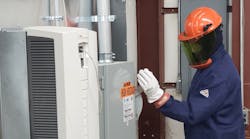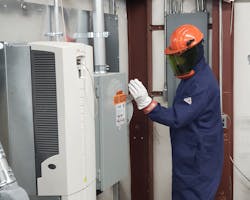Over the last several years, the electrical industry has seen a significant focus on electrical safety awareness, particularly surrounding arc flash hazards. This increased awareness includes an understanding that employers must provide electrical safety training for employees who they believe are exposed to electrical hazards. However, in my experience, there is little consistency in the application of this training. In addition, there is also a lack of understanding about how electrical safety training fits into the overall electrical safety program as intended by the NFPA 70E, 2018 edition.
Let’s run through a few common misconceptions I have seen in the field regarding electrical safety training and then clarify the real training requirements.
Misconception #1
“All of my electrical workers receive electrical safety training when they first hire in to my company.”
This is a common misunderstanding of the requirement for electrical safety training. Many employers believe the requirement is to provide NFPA 70E-related safety training one time in the career of an electrical worker and that worker will know all they need to know about electrical safety. However, in previous revisions of the NFPA 70E, the committee recognized the need for recurring electrical safety training and now have it mandated as a requirement at a frequency of no less than three years [Sec. 110.2(A)(3)]. I see two reasons why this requirement is necessary. The more obvious one is that the standard gets revised every three years, and with each revision come changes and/or additions to the required electrical safe work practices. Another reason for recurring training is that the electrical hazards are not visible or audible during most normal work scenarios. This absence of clear indication when it comes to electrical hazards results in the tendency to subconsciously downplay the risk associated with electrical work.
Misconception #2
“I’ve been doing it this way for years, and nothing has ever happened to me. Why should I change my methods now?”
Properly developed and delivered electrical safety training provides a reminder of the potential life-altering severity of electrical hazards combined with the understanding of common causes of personnel injuries. This approach is designed to help electrical workers maintain an awareness that not all electrical-related injuries are a result of human error; we must always protect ourselves from exposure to electrical hazards.
Misconception #3
“A skilled electrical worker should already have the knowledge needed to work on electrical equipment safely.”
Per NFPA 70E, a qualified electrical worker is someone who has the skills and knowledge to recognize the hazards they are exposed to as well as the
techniques and personal protective equipment (PPE) required to be protected from electrical hazards. However, it is the employer’s responsibility to ensure employees are qualified to the level of hazards the employee is potentially exposed to [Sec. 110.2(A)]. Furthermore, with the NFPA 70E revision frequency of every three years, it is the responsibility of the employer to provide training that keeps the employees current with the most recent requirements. Industry experts are still learning about the arc flash hazard phenomenon, and technology is rapidly changing in response to arc flash and shock protection requirements. Knowledge of electrical hazards and associated safe work practices is not a onetime effort — it’s a career long journey.
Misconception #4
“All of my electricians receive NFPA 70E-related training every three years.”
This statement sounds like it lines up perfectly with the requirements of NFPA 70E. However, a serious oversight is implied in this statement, because typically more employees than just electricians need electrical safety training. The requirement states that employees who are exposed to electrical hazards must be trained according to the level of their exposure. There are several categories of employees who are exposed to electrical hazards but do not receive appropriate safety training. These include engineers, instrument technicians, HVAC technicians, facility operators, etc. Employers must evaluate each category of employee to determine if he or she is exposed to arc flash or shock hazards and, if so, provide the appropriate level of training. In some cases, making minor work task changes can shift certain categories of employees away from electrical hazard exposure.
Misconception #5
“We have in-house electrical training that we give our electrical workers every year.”
This is another scenario that sounds good on the surface. However, in most cases, I find that the in-house training has remained the same for several years. If your company chooses to provide training in-house, you must also ensure you have a trainer who is keeping current with the latest revisions of NFPA 70E and updating your training as needed. If this is the case, then the trainer can also fill the requirement for performing the required audits to ensure the training has the intended effect of applying electrical safe work practices.
Summing it All Up
The requirements for training are that the employer must provide electrical safety training per the level of electrical hazard exposure of the employee. This means not all employees must receive the same level of electrical safety training. The training is also required to be repeated every three years.
This is to provide the opportunity for the training to be updated to cover the new requirements in NFPA 70E and for the employees to receive a refresher on the existing requirements that have not changed. This recurring training is also intended to provide a reminder of the reality of electrical hazards as well as their potential severity.
As electrical workers, we must never let our guard down to the reality that within milliseconds, we can be exposed to energies that can be life changing and potentially fatal. But is providing a proper training program for your employees enough?
The short answer is no; training alone is not enough. Electrical safety training cannot be viewed as simply placing a check in the box for putting employees through a training course. Electrical safety training is one step in an electrical safety program that needs to be constantly refreshed. The NFPA 70E committee recognized this and established several requirements for an overall electrical safety program that is designed to move the culture in a positive direction when applied appropriately.
One important piece of this culture change is the requirement to perform audits. It is not enough for an employer to provide appropriate training and then assume every employee will follow the requirements presented during the training. The employer is also required to conduct annual audits of electrical work to ensure the appropriate electrical safe work practices are being followed. The audits need to be performed by someone knowledgeable about safe electrical work practices so that they can determine if employees are indeed putting the requirements into practice. The best approach would be to have someone knowledgeable in safe electrical work practices regularly interacting with employees in the field to encourage the application of the safety principles taught during the training.
The bottom line is that appropriate electrical safety training is invaluable for electrical workers, but it is not a one-time solution for electrical safety. The training must be combined with an NFPA 70E-compliant electrical safety program that is designed to continuously drive the electrical safety culture toward zero electrical safety incidents.
Northcott is a professional engineer licensed in the state of Tennessee and a senior power engineer with Jacobs Technology, Inc., in Tullahoma, Tenn. He is also an NFPA 70E compliance subject matter expert, a principle member of the NFPA 70B Committee, electrical safety trainer, certified maintenance and reliability professional, and certified reliability leader. He can be reached at [email protected].
From the Author
Over the last several years, I have been blessed with the opportunity to visit many commercial, industrial, and government facilities across the United States to provide electrical safety training and audits. During that time, I have come
to realize that there are several common misunderstandings or misapplications that must be addressed regardless of the type or location of the facility. This “Safety Sense” department will address these issues in a short format, addressing frequently asked questions. If there are topics you would like covered, please email me at [email protected].





